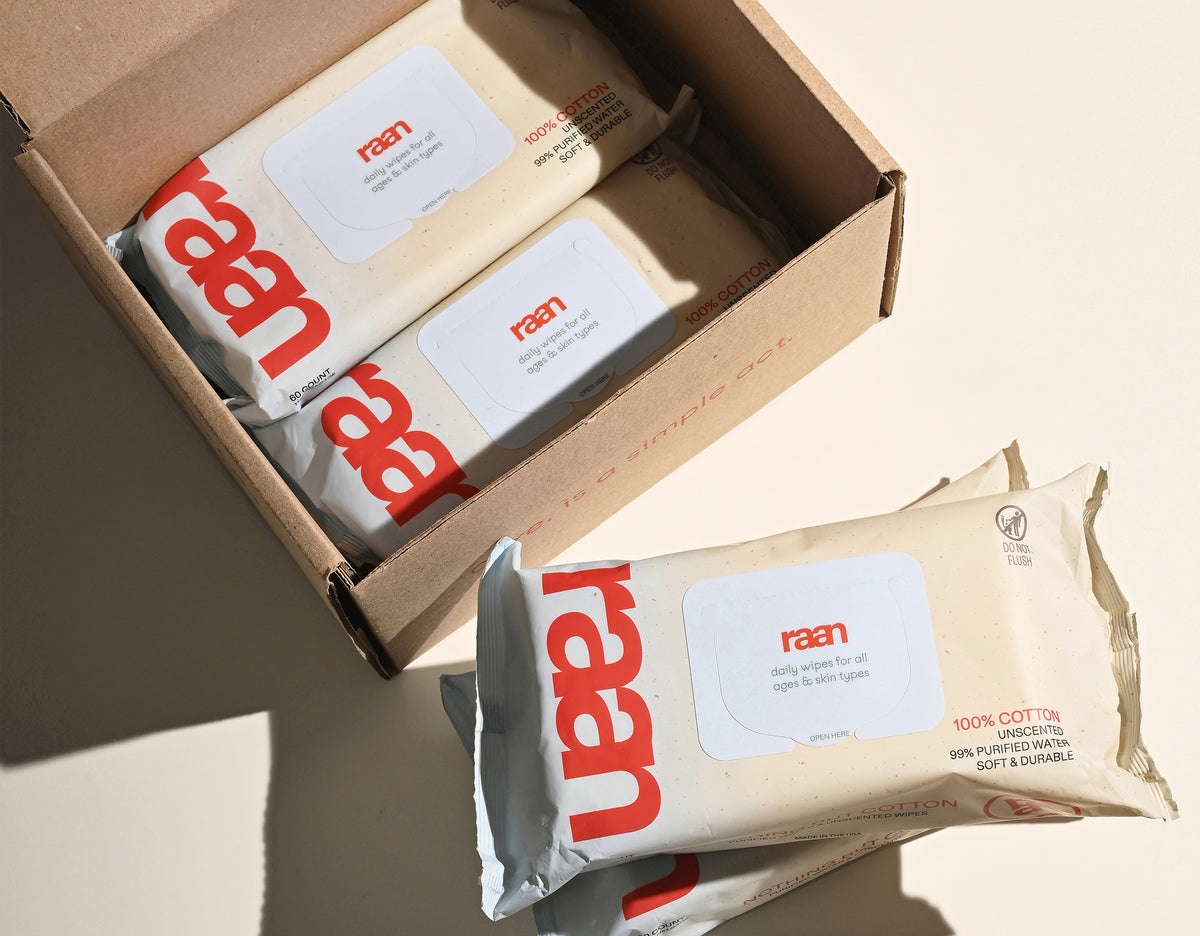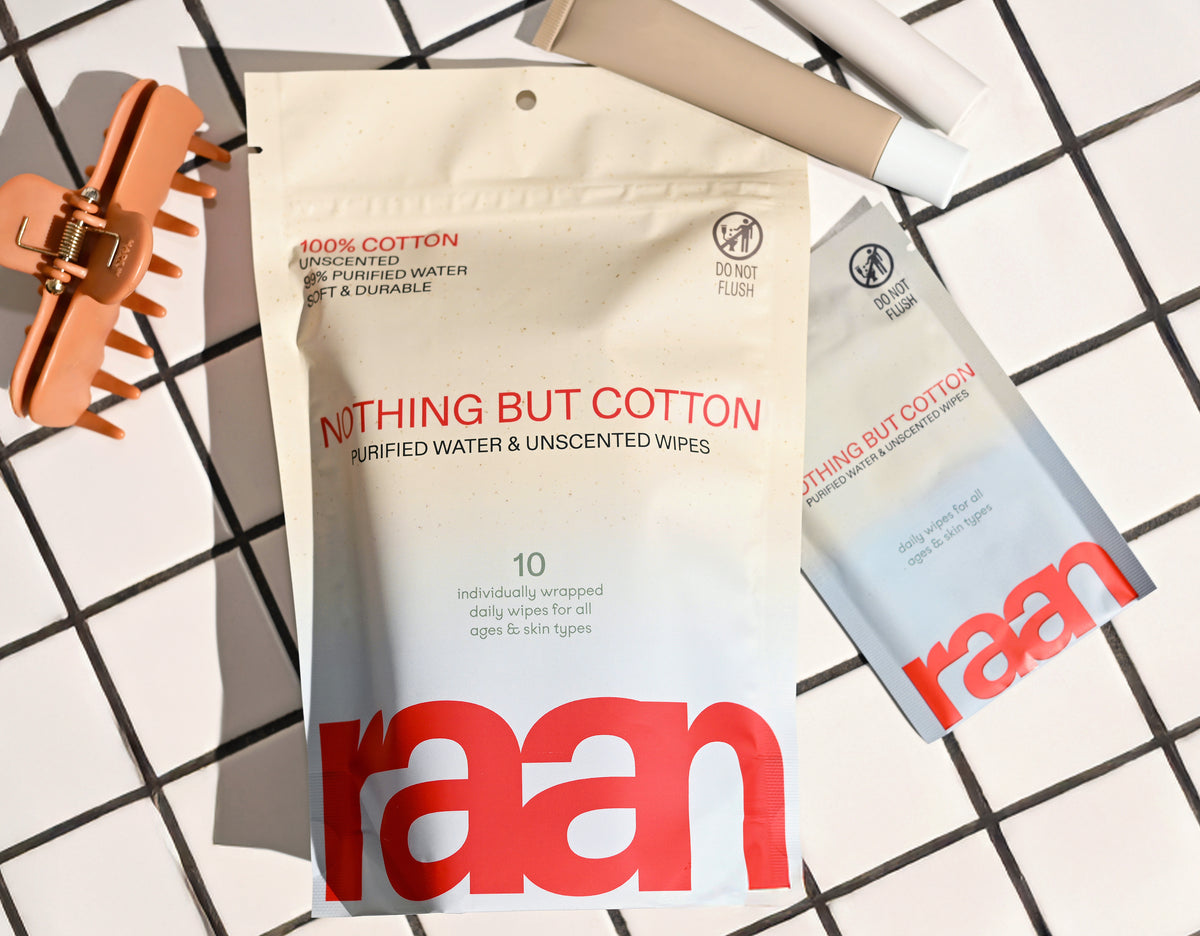Key Takeaways
- Most wipes labeled "flushable" do not break down like toilet paper and can cause plumbing blockages.
- Flushable wipes often contribute to costly issues at wastewater treatment facilities.
- The safest option is to use wipes made from natural materials and dispose of them in the trash.
- Understanding flushability involves more than convenience; it requires awareness of environmental and plumbing impacts.
Table of Contents
- What Are "Flushable" Wipes? Meaning, Purpose & Real-World Claims
- The Flushability Controversy, Science, Public Warnings & How Wipes Behave
- Material Science, What's Inside Flushable Wipes (And Why It Matters)
- Environmental Impact, Flushable Wipes vs. Pipes, Waterways & Waste
- How to Choose the Best Flushable Wipes, Transparency, Skin Safety & Everyday Use
- Best Flushable Wipes for Different Needs, By Skin Type, Use Case & Preferences
- For sensitive skin and newborns
- The Material Science That Actually Matters
- Environmental Reality Check: What Happens After You Flush
Best Flushable Wipes, Facts, Impact & Real-World Choices for Everyday Messes
The best flushable wipes market is built on a contradiction. You'll find hundreds of products labeled "flushable," yet wastewater treatment facilities across the country are spending millions to remove these same wipes from their systems. As someone who's spent years decoding misleading clean claims, I've learned that the flushability question isn't just about convenience, it's about understanding what we're actually putting down our drains and onto our skin.
Real talk: most wipes marketed as flushable contain synthetic fibers, mystery preservatives, and materials that don't break down the way toilet paper does. But that doesn't mean all wipes are created equal. Some are genuinely safer for your pipes, your skin, and the environment, if you know what to look for. Unbleached, 100% cotton baby wipes for sensitive skin are an excellent example of a safer, more natural option.
For those who need a portable solution, individually wrapped, unbleached cotton pocket wipes offer convenience without compromising on material safety or environmental impact.
What Are "Flushable" Wipes? Meaning, Purpose & Real-World Claims
"Flushable" wipes are marketed as wet wipes that can safely go down the toilet after use, unlike traditional baby wipes or cleaning wipes that require trash disposal. The industry defines them as products designed to pass through household plumbing without creating immediate blockages, but that's where the clarity ends.
These wipes serve real needs: quick bathroom cleanup, diaper changes when water isn't available, travel refreshing, and gentle cleansing for sensitive skin. New parents especially gravitate toward them for overnight diaper changes, while busy professionals use them for on-the-go freshening up.
The marketing landscape promises convenience without consequence. Brands use terms like "septic-safe," "breaks down like toilet paper," and "sewer-friendly" to suggest these wipes behave just like toilet paper once flushed. The reality? Industry guidelines only require that wipes clear your immediate pipes, not that they fully disintegrate in municipal water systems.
- Bathroom use: Post-toilet cleanup, especially for sensitive skin
- Baby care: Diaper changes when traditional cleanup isn't enough
- Travel: Personal hygiene when showers aren't available
- Quick refresh: Face and body cleansing between proper washing
- Pet messes: Cleaning paws, fur, and accidents
Consumer Reports testing reveals that many products labeled as the best flushable wipes actually fail to break down within 30 minutes of agitation, the timeframe toilet paper dissolves in. This gap between marketing and performance is why cities from New York to San Francisco advise against flushing any wipes, regardless of labeling. For a deeper dive into the topic, see this best wipes guide.
The Flushability Controversy, Science, Public Warnings & How Wipes Behave

The flushability debate isn't just plumbing drama, it's rooted in measurable science. When Consumer Reports tested leading "flushable" wipes, they found that most failed basic disintegration tests that toilet paper passes easily. While toilet paper breaks apart within seconds of agitation, many flushable wipes remained largely intact after 30 minutes of testing.
Municipal water systems tell a different story than wipe packaging. In 2023, New York City spent over $18 million removing wipes and related blockages from their sewer system. London's Thames Water reports that wipes contribute to 75% of their sewer blockages, creating massive "fatbergs" that require industrial removal.
| Product Type | Breakdown Time | Passes Consumer Reports Test |
|---|---|---|
| Standard toilet paper | Under 30 seconds | Yes |
| Leading flushable wipe brands | 30+ minutes (many don't break down) | Most fail |
| Regular baby wipes | Hours to days | No |
The testing standards themselves are part of the problem. The industry's INDA/EDANA guidelines focus on whether wipes can physically move through pipes, not whether they break down completely. This creates a technical loophole where products can claim flushability while still causing downstream problems.
What actually happens when you flush? Synthetic fibers in conventional wipes don't disintegrate like natural materials. They may clear your toilet and even your home's main line, but they often snag on roots, pipe joints, or other debris further down the system, creating blockages that affect entire neighborhoods.
Material Science, What's Inside Flushable Wipes (And Why It Matters)
The difference between wipes that actually break down and those that just claim to comes down to materials. Most conventional wipes, even those labeled flushable, contain synthetic fibers like polyester, polypropylene, or viscose rayon that resist breaking apart in water.
Toilet paper is made from short wood fibers specifically engineered to disintegrate quickly when wet and agitated. True flushable wipes should follow similar principles, but many commercial options include synthetic fibers, plastics, or chemical binders that prevent proper breakdown.
The reality is more complex than marketing suggests. While some best flushable wipes do break down faster than regular wet wipes, independent testing shows most still take significantly longer to disintegrate than toilet paper, sometimes hours instead of seconds. This gap between "flushable" claims and actual performance has created widespread confusion among consumers who want convenient cleaning without plumbing headaches.
For more on the science behind biodegradable options, check out this biodegradable wipes resource.
Environmental Impact, Flushable Wipes vs. Pipes, Waterways & Waste
The environmental story of flushable wipes extends far beyond your bathroom. Even wipes that successfully navigate home plumbing face additional challenges at wastewater treatment facilities, where they can clog screens, damage equipment, and contribute to costly maintenance issues.
Municipal water authorities report spending millions annually on wipe-related blockages and equipment repairs. In 2023, New York City attributed over 70% of sewer blockages to wipes and other non-toilet paper items, despite many being labeled as flushable. The problem isn't just individual pipes, it's systemic infrastructure strain.
Packaging matters equally: Traditional wipe containers use hard plastic lids and minimal recycled content. Raan's packaging approach eliminates 70% of this plastic waste by skipping the hard lid entirely, while incorporating 35% post-consumer recycled materials in the pouch itself. Small changes in packaging design can significantly reduce the environmental footprint of everyday products.
For eco-conscious users, the best approach combines smart material choices with responsible disposal habits. Even genuinely biodegradable wipes perform better when disposed of in household waste rather than flushed, especially in homes with septic systems or older plumbing. For a broader perspective on the environmental impact of disposable wipes, see this external resource on the rising costs and opportunities of disposable wet wipes.
How to Choose the Best Flushable Wipes, Transparency, Skin Safety & Everyday Use

Smart wipe shopping starts with reading ingredient lists like you would for skincare products. The best flushable wipes have short, clear ingredient lists with recognizable components. Avoid products that list "fragrance" without specifying what that means, or use vague terms like "cleansing agents" instead of naming specific ingredients.
Certification credibility: Look for third-party verification from organizations like EWG (Environmental Working Group) rather than self-proclaimed "eco-friendly" or "natural" claims. EWG verification requires extensive testing and ongoing monitoring, providing real accountability behind the marketing.
Consider your specific use case when evaluating options. Travel requires compact, leak-proof packaging. Sensitive skin needs fragrance-free formulations with minimal preservatives. Baby care demands the gentlest possible ingredients. Home use can prioritize larger pack sizes and sustainable packaging.
| Feature | Typical Flushable Wipes | Raan Cotton Wipes |
|---|---|---|
| Base Material | Viscose/cellulose blend | Unbleached 100% cotton |
| Ingredient Count | 10-15+ ingredients | 5 EWG-verified ingredients |
| Preservatives | Synthetic preservatives | Food-grade only |
| Certifications | Self-claimed "natural" | EWG Verified, Natural Cotton |
| Packaging Plastic | Hard plastic lid standard | 70% less plastic, no hard lid |
If you're looking for a convenient way to try a variety of options, the mess-ready pack offers a curated selection for different needs.
Best Flushable Wipes for Different Needs, By Skin Type, Use Case & Preferences
Different life situations call for different wipe solutions. Rather than assuming one product works for everyone, consider which features matter most for your specific circumstances and skin requirements.
For sensitive skin and newborns
Prioritize wipes with minimal ingredients and recognized safety certifications. Look for EWG Verified products that eliminate fragrances, bleaching agents, and synthetic preservatives. Unbleached cotton materials offer the gentlest contact with delicate skin while avoiding the microplastics found in conventional wipes. For more information on choosing the right wipes for newborns, see this best wipes for newborn guide.
For eco-conscious households, focus on packaging innovations alongside ingredient transparency. Products using 70% less plastic in packaging or incorporating post-consumer recycled content address environmental concerns without compromising function. Consider the full lifecycle impact, from material sourcing to disposal methods.
For busy professionals and parents, durability and moisture retention become key factors. Wipes that maintain effectiveness without hard plastic lids offer convenience while reducing waste. Multi-purpose formulations that work safely on both skin and surfaces provide practical value for time-pressed users. If you're just starting out, the starter set is a practical way to cover all your bases.
The Material Science That Actually Matters

Understanding what goes into wipes helps explain why some products perform better than others, and why material choices directly impact both your skin and your plumbing.
Cotton vs. synthetic blends represents the fundamental divide in wipe construction. Pure cotton fibers break down more readily in water systems while providing natural absorbency and strength. Synthetic materials like polyester or polypropylene create the durability that makes wipes "flushable" in marketing terms, but these same plastics resist breakdown in real-world plumbing scenarios.
Preservative systems vary dramatically between products. Food-grade preservatives like sodium benzoate and potassium sorbate offer effective protection against bacterial growth without the skin sensitization risks associated with formaldehyde-releasing compounds or methylisothiazolinone found in conventional options.
Key Insight: Products with five or fewer ingredients aren't just simpler, they're safer. Each additional component increases the likelihood of skin reactions or environmental persistence.
pH balance considerations often get overlooked but significantly affect skin compatibility. Citric acid naturally adjusts pH to match healthy skin levels, while harsh alkaline formulations can disrupt your skin's protective barrier. This becomes especially critical for repeated use on sensitive areas.
The processing method matters as much as the base material. Unbleached cotton retains its natural fiber structure and biodegradability, while bleached alternatives introduce chlorine compounds that persist in waterways and can trigger skin sensitivities. For a scientific perspective on wipe breakdown and environmental impact, see this external study on wet wipes and wastewater systems.
Environmental Reality Check: What Happens After You Flush
The environmental story of flushable wipes extends far beyond your bathroom, creating ripple effects through municipal water systems and natural ecosystems that most consumers never see.
Wastewater treatment challenges represent the most immediate concern. Even wipes that eventually break down often persist long enough to clog pumps, wrap around equipment, and require manual removal at treatment facilities. New York City alone spends over $18 million annually addressing wipe-related infrastructure problems.
Microplastic pollution occurs when synthetic wipe materials fragment rather than fully dissolve. These particles pass through treatment systems and accumulate in waterways, where they're consumed by aquatic life and eventually enter food chains. Cotton-based alternatives eliminate this pathway entirely.
Packaging innovation offers another avenue for environmental improvement. Traditional hard plastic lids create unnecessary waste, while flexible packaging using post-consumer recycled content reduces overall plastic consumption. Some manufacturers achieve 70% plastic reduction through thoughtful design choices.
| Material Type | Breakdown Time | Environmental Impact | Infrastructure Risk |
|---|---|---|---|
| Toilet Paper | 15-20 seconds | Minimal | Very Low |
| Synthetic Blend Wipes | 30+ minutes | Moderate-High | High |
| Regular Baby Wipes | Does not break down | High | Very High |
Disposal alternatives provide options for environmentally conscious users. Composting works for cotton-based wipes with minimal chemical processing, while trash disposal eliminates plumbing risks entirely. The key is matching disposal method to material composition and local waste management capabilities.
Frequently Asked Questions
What does 'flushable' really mean when it comes to wipes, and how do these wipes behave in plumbing systems?
'Flushable' wipes are marketed as safe to flush down the toilet, but in reality, most don’t break down like toilet paper. They often stay intact in plumbing systems, which can lead to blockages and costly repairs downstream.
Why do most flushable wipes cause blockages and environmental issues despite being marketed as safe to flush?
Many flushable wipes contain synthetic fibers and materials that don’t disintegrate quickly in water. This causes them to accumulate in pipes and wastewater facilities, leading to plumbing blockages and environmental harm.
What materials should I look for in flushable wipes to ensure they are safe for plumbing, skin, and the environment?
Look for wipes made from natural fibers like unbleached, 100% cotton that break down more easily in water. Avoid synthetic plastics and mystery preservatives. Certifications from independent wastewater organizations can also guide safer choices.
Are there safer alternatives to conventional flushable wipes for sensitive skin and on-the-go use?
Yes. Wipes made from unbleached, 100% cotton with minimal, EWG-verified ingredients offer a gentler, more transparent option. For convenience, individually wrapped cotton wipes provide portability without compromising safety or environmental impact.






